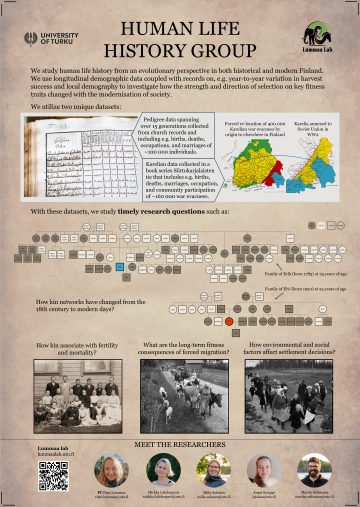Research themes
Human life history
Even though most modern humans survive to old age, differences among individuals can still lead to selection favouring certain heritable traits: not everyone has the same family size, and many forego reproduction altogether.
Few studies have examined how the modern environment itself fuels evolution, and how the recent drastic demographic shifts to low birth and death rates have affected the opportunity for selection or specific trait selection.
We use longitudinal demographic data from Finland, coupled with records on year-to-year variation in harvest success and local demography, to investigate how the strength and direction of selection on key fitness traits changed with the modernisation of society.
We also quantify the long-term changes in the structure of family networks and provide knowledge on how these changes are associated with fertility and mortality outcomes over time and during quantifiable hardships such as famines, disease outbreaks and political conflicts, revealing the importance of kin on resilience.
The human life history database is a large multi-generational demographic dataset following the same family lineages spanning 300 years and up to 15 generations. The dataset contains information on e.g. births, deaths, marriages, places of residence, causes of death and occupations.
MiKARELIA database consists of life events of 160,000 Karelian war evacuees displaced during WW2. The evacuees were interviewed for Siirtokarjalaisten tie book series, which includes records on birth, death, marriage, family, occupation, participation in a paramilitary organisation, membership in cultural organizations, religiosity, political affiliation, union membership and complete settlement history.
Both databases have also recently been combined with modern day registry data from the Digital and Population Services Agency.

Myanmar timber elephant project
Asian elephants and many other larger mammals are threatened by extinction because of habitat loss, climate change, human exploitation or a combination of all of those factors.
We study the multi-faceted life of the world‘s largest population of captive Asian elephants. These elephants work in the timber industry in Myanmar and are under human control during the day, but they can roam freely after “working hours” interacting with their conspecifics. The semi-captive nature of this population allows investigating questions that would be impossible to answer using fully wild animals.
Our individual-based study uses a detailed longitudinal data set, which combines several decades of demographic data on the entire population with a more recent collection of data on individual phenotypes in the field.
With the current low rates of survival and reproduction, the future of Myanmar’s timber elephant population is insecure. This semi-captive population can act as a source, and therefore, the health and sustainability of the captive population is tightly linked to the declining wild population.
Using a manifold of diverse methods, our research aims to determine factors affecting health, fertility and mortality rates in the captive population and devising strategies to improve them.
At the same time, we address timely research questions in evolutionary behavioural ecology, human-animal interactions, animal welfare and conservation.

Human evolutionary health
Human health stems partly from adaptations to diverse ancestral environments and the challenges posed by our rapidly changing modern world. Using data from the past and contemporary Finland, we focus on four topics on the evolution of human health.
Past selection and current health: We investigate the impact of various selection pressure (famines, epidemics) on human traits, such as the genetic make-up or susceptibility to specific diseases (e.g. auto-immune diseases).
Spatial epidemiology: We study the prevalence and spread of past and current epidemics, its regional variation across Finland in order to understand which factors (genetic, cultural, environmental) can explain variation in human health.
Social and kin network: We study the impact of family and social network on the risk of getting ill and general health condition. Moreover, we study whether the potential change of family and social network through time impacted contemporary Finns.
Impact of medical advances: Using the particular case of vaccination against smallpox, we study its implementation in Finland throughout the 19th century and its impact on dynamics of smallpox epidemics.

Mammal behaviour research
Our diverse team members specialise in investigating the behaviour of working animals and pets from various perspectives.
We delve into areas such as the expression of animal emotions, their cognition, their interactions with humans, their personality types, and their social organisation.
Our overarching goal is to gain comprehensive insights into how animals interact with and are influenced by their environments. Our aim is to gain holistic knowledge that will contribute to enhance animal welfare.

Human diversity
In the Human Diversity consortium we study how ancient historical encounters between humans have affected the genetic and cultural legacy of modern populations focusing especially in the Uralic language speaker area.
Archaeology and ancient DNA are used to create a picture of which people have inhabited Finland in the past, and what their cultures were like.
Natural language processing, digital linguistics, and AI are used to develop methods to extract knowledge from free text and to discover how digital communication and contacts in the digital world affect human diversity.
Evolutionary language sciences explore human linguistic history and language change by using Uralic languages and Finnish dialects as study objects.
Digitized chuch books help us understand migrations, birth and death rates, and disease. Genomic data is used to infer past selection regards immunity and diet.


